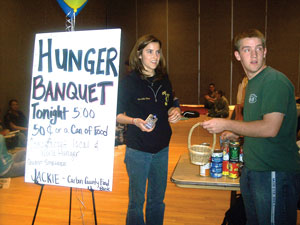Hunger Banquet inspires students
How would you feel if you barely had enough money to pay the bills, with near nothing left over for food? What if your children went to school hungry everyday? How would you deal with it?

This archived article was written by: Kellie Henderson
How would you feel if you barely had enough money to pay the bills, with near nothing left over for food? What if your children went to school hungry everyday? How would you deal with it?
The Hunger Banquet, an activity sponsored by the SUN Center, gave students a small sample of this lifestyle. Students entered the Hunger Banquet by donating a can of food, then were asked to draw a ticket with a number on the back. This number determined where you would sit. Those who drew a one on their ticket sat on a newspaper on the floor. Number two tickets also sat on the floor, but on blankets; and anyone who drew a three ticket, sat at a table.
Next, the students were served dinner. The students with the number one were served rice on a tortilla, twos got rice and beans on a tortilla, and those in the three category were served a three-course meal.
The three categories represent the distribution of wealth worldwide. The three category was the largest, representing third-world countries; with two representing second-world countries and being slightly smaller; and one, the smallest category, represented the wealthy first-world nations.
After dinner, students listened to Jackie Butkovich, from the Southeastern Association of Governments, a nonprofit organization that takes care of three food banks in Carbon, Emery and San Juan counties. She said most of those who need food from the food bank are elderly or disabled and the one meal they eat at the food bank may be the only nutritional food they eat all day.
In San Juan, the food bank people travel to the Indian Reservation and feed senior citizens, many who live without refrigerators or electricity. Conditions of poverty, Butkovich explains, increase all kinds of problems in families. Small colds or flu turn into major illnesses that require hospitalization. Children often do not get enough to eat and cannot concentrate in school or get along with their peers. Anxiety and aggression increase, and often mental health services are needed.
According to Butkovich, about 250 Utahans live in this condition statewide – at or below the poverty level. The poverty line is a government standard of a person’s monthly income. The poverty line for a three-person household is $1,400 or less, and for one person it is $847 or less. Although many of the disabled or elderly receive social security, this only amounts to between $600-700 per month, leaving these people well below the poverty line.
Sam Heslop, who attended the banquet, stated, “It’s stuff we’ve all heard, that we have plenty of food, we just need to actually take action and do something.” For next week, the SUN Center is having a trick-or-treat for hunger drive where students can collect cans and donate them to the food bank. If you or someone you know is in need of food, contact Kathy Murray in the SUN Center for assistance.




